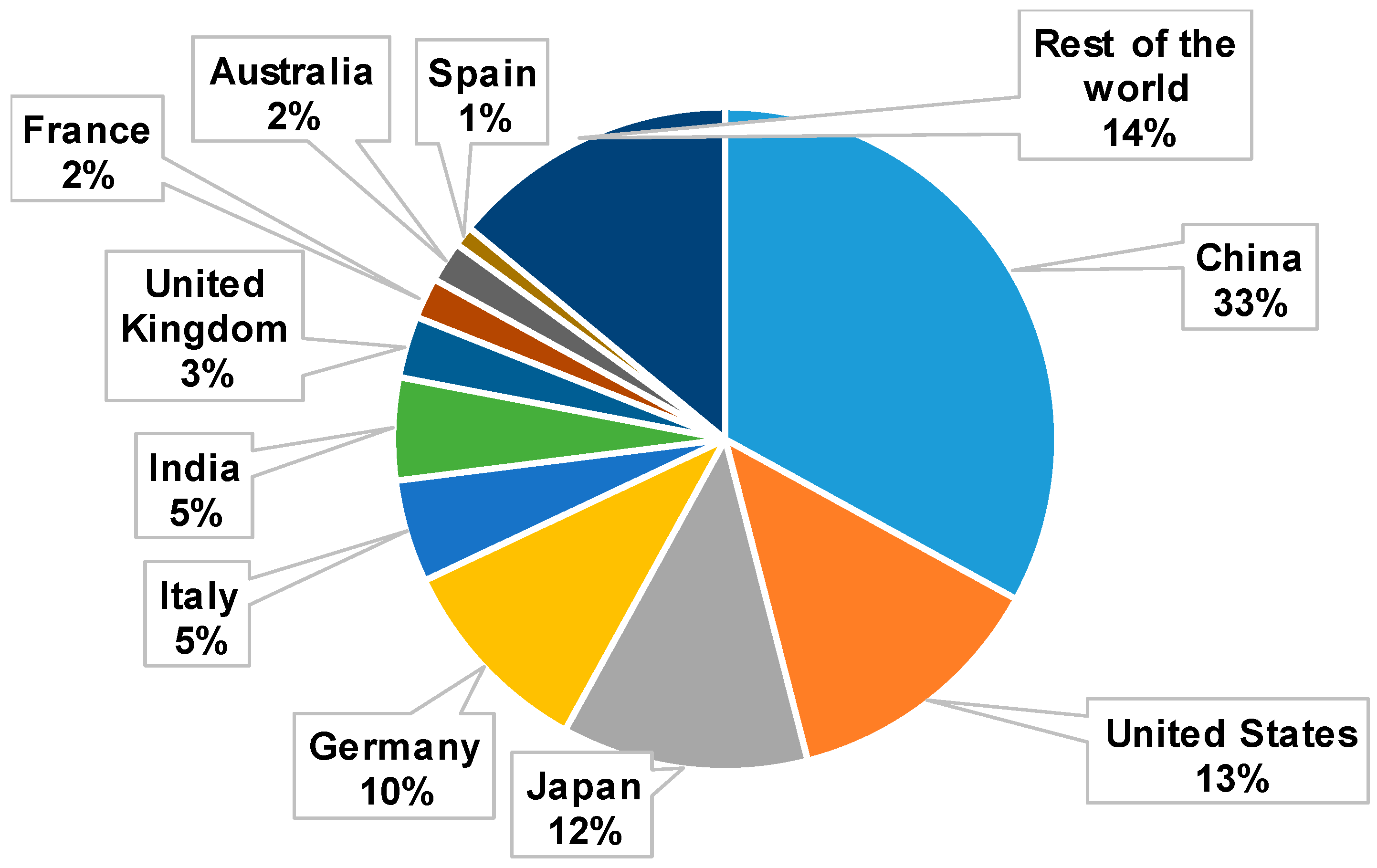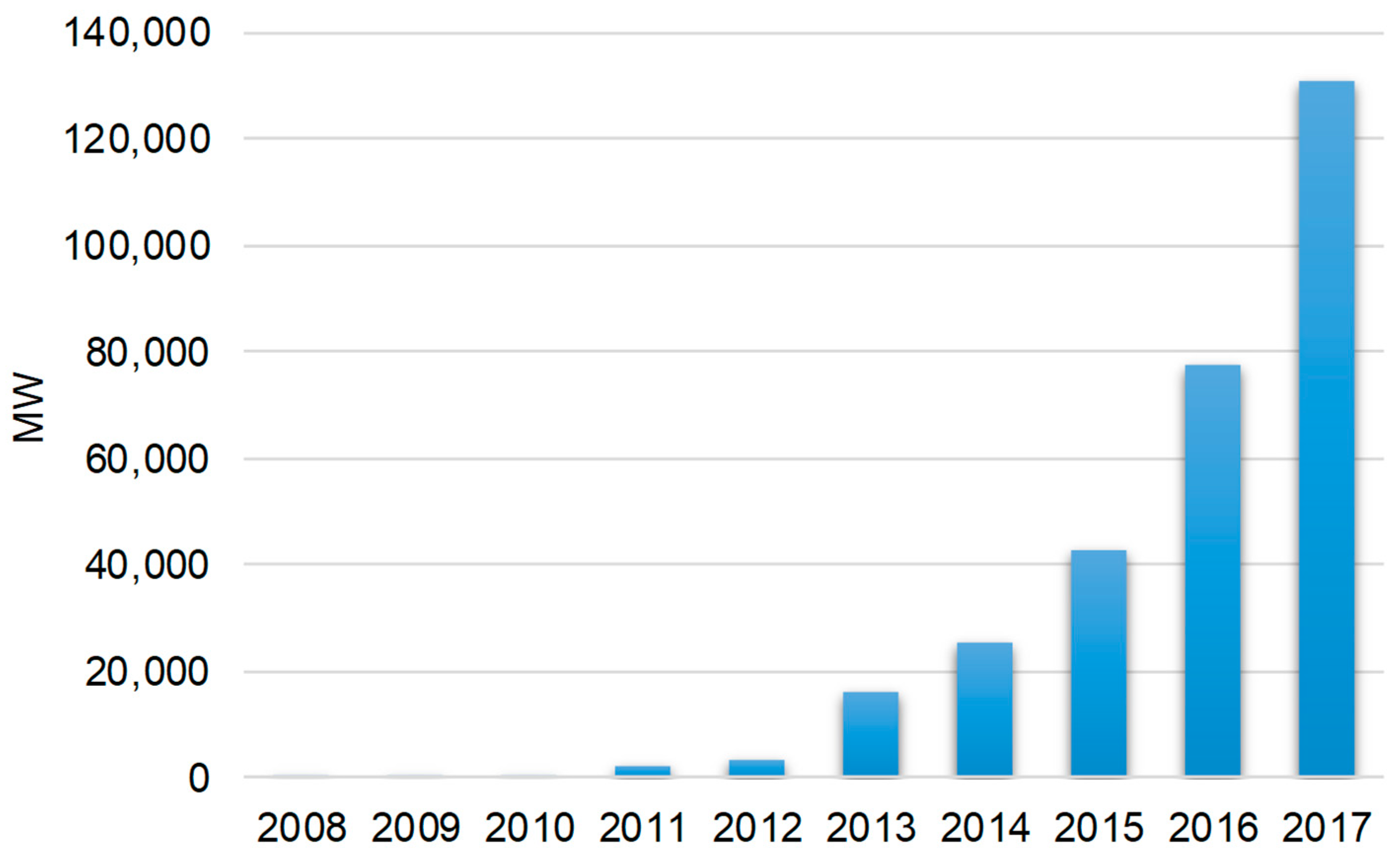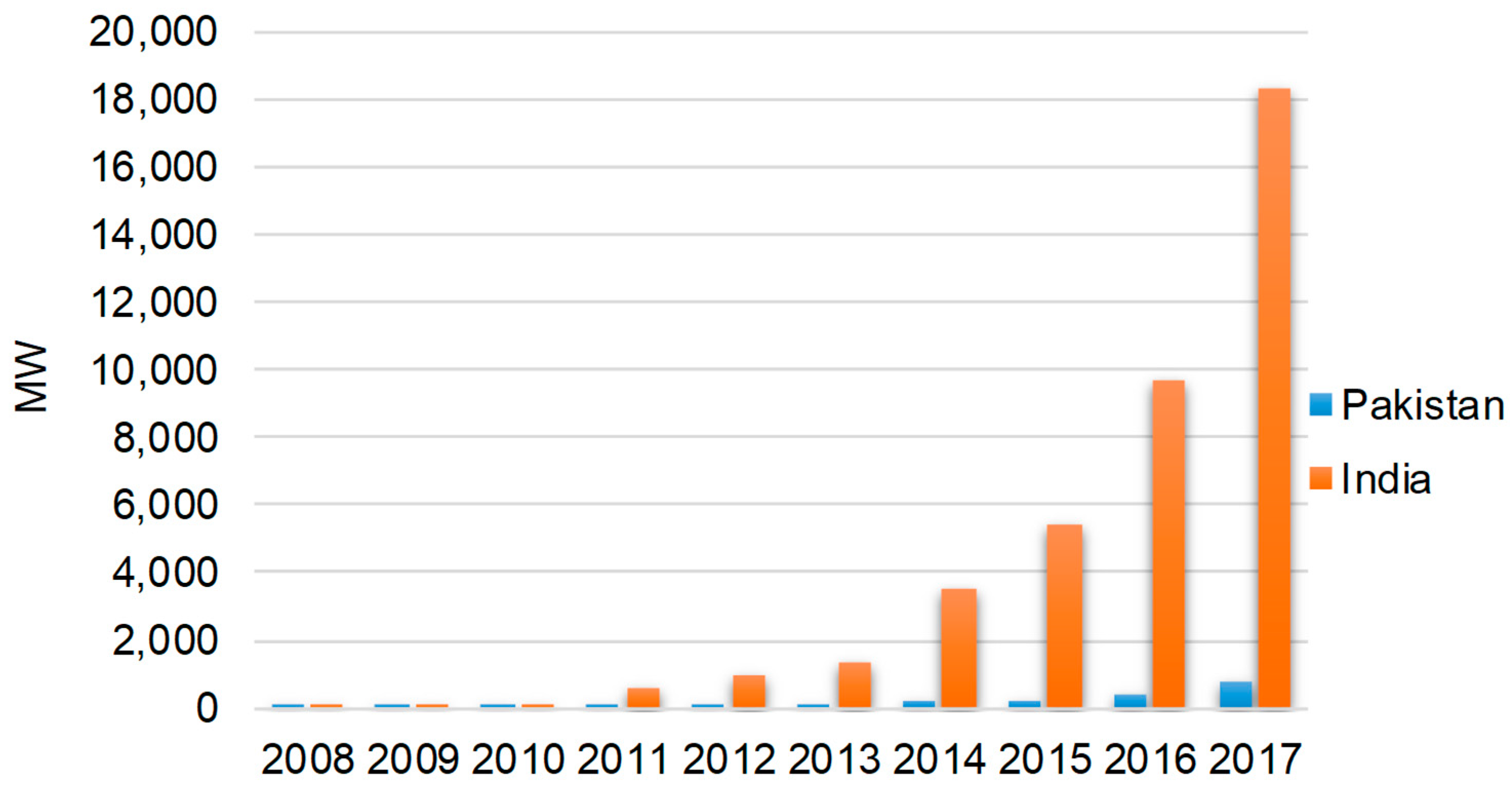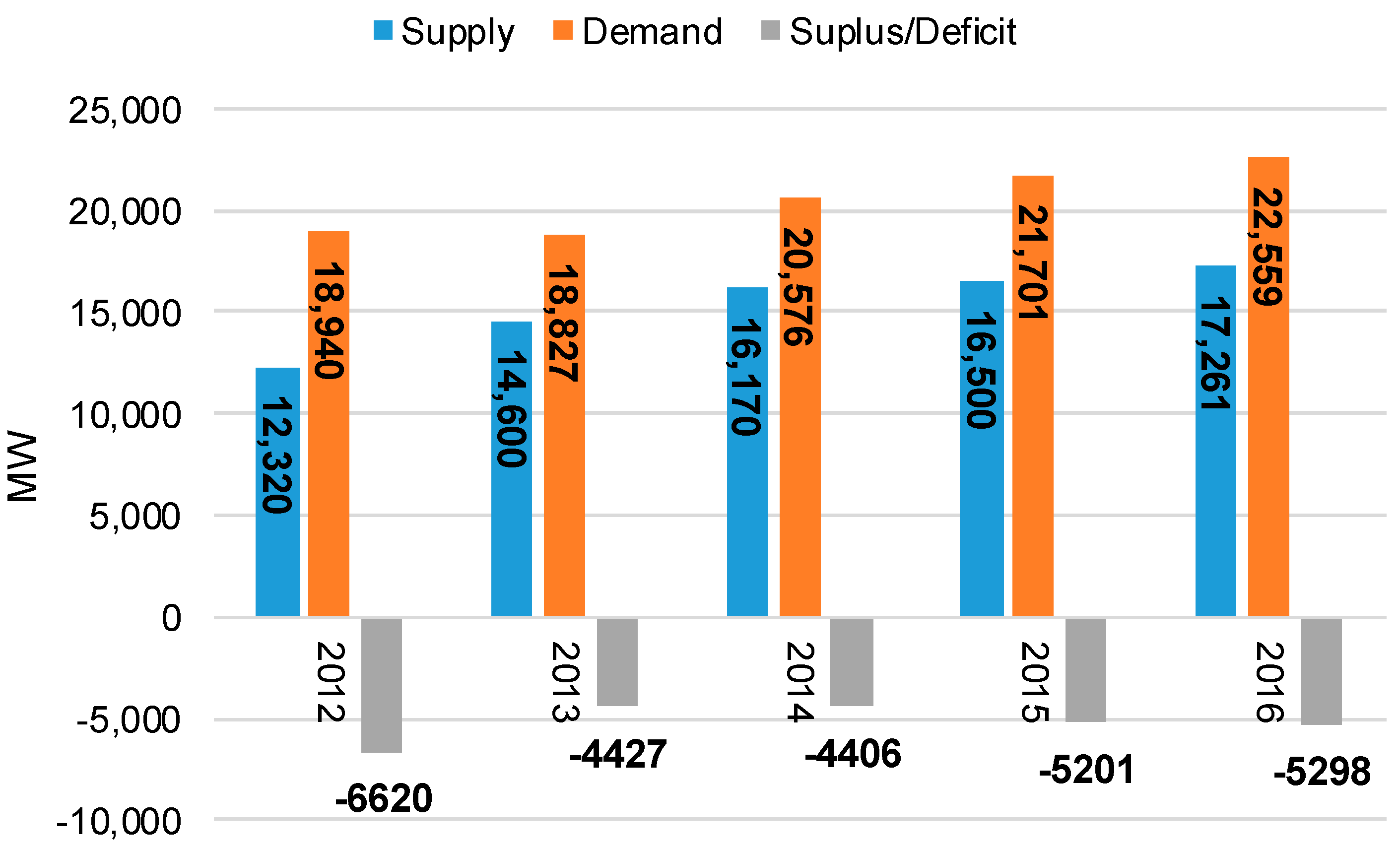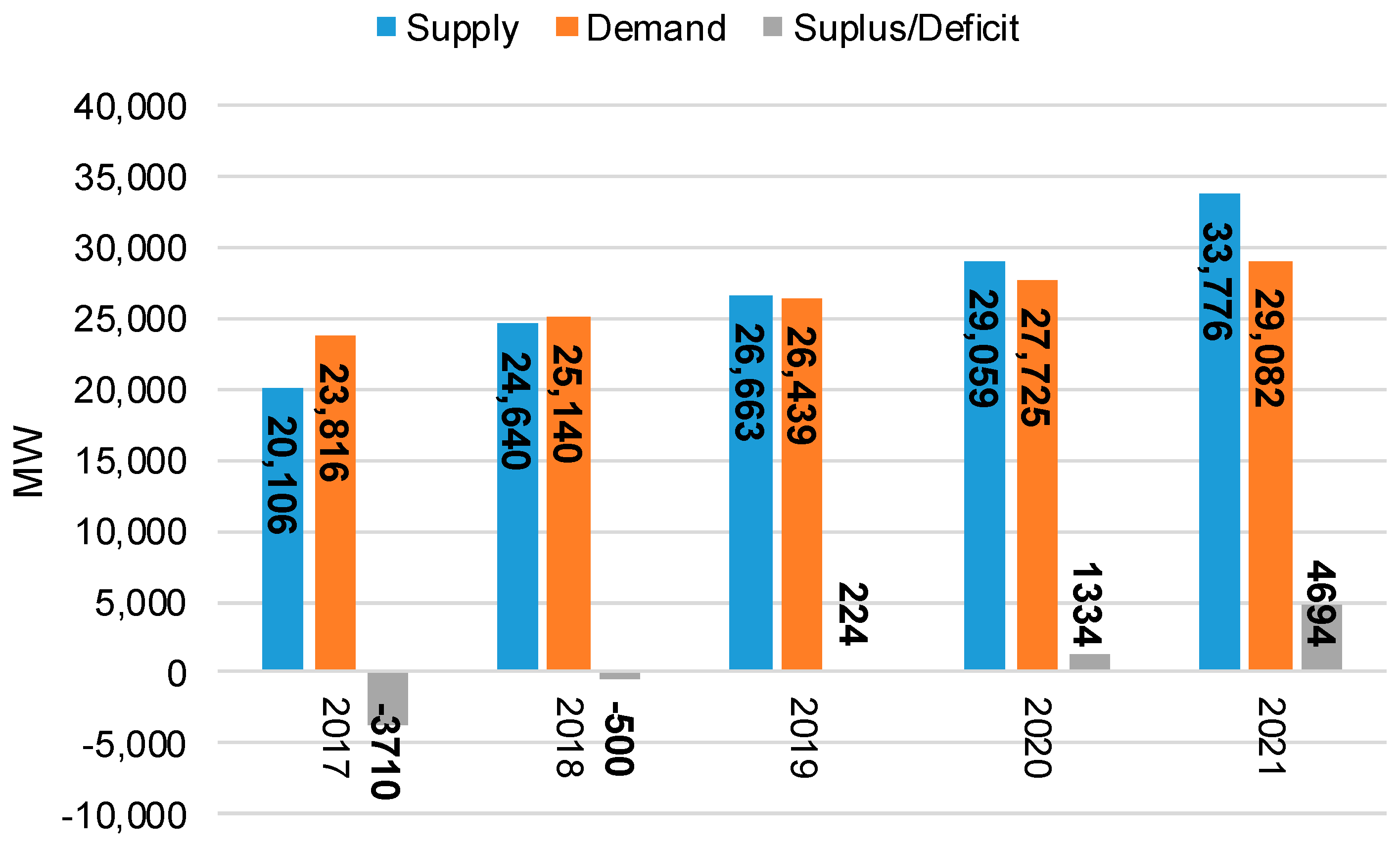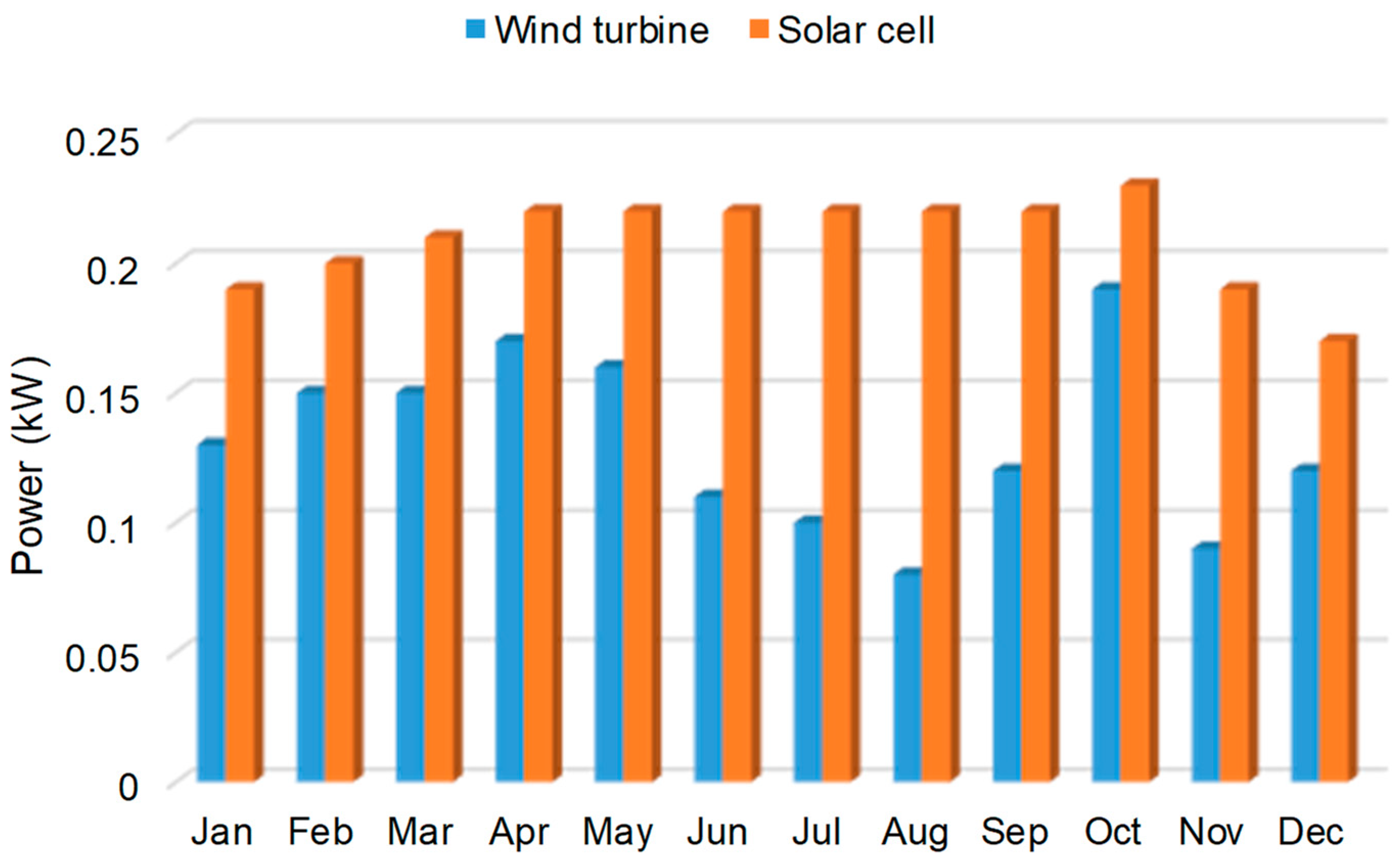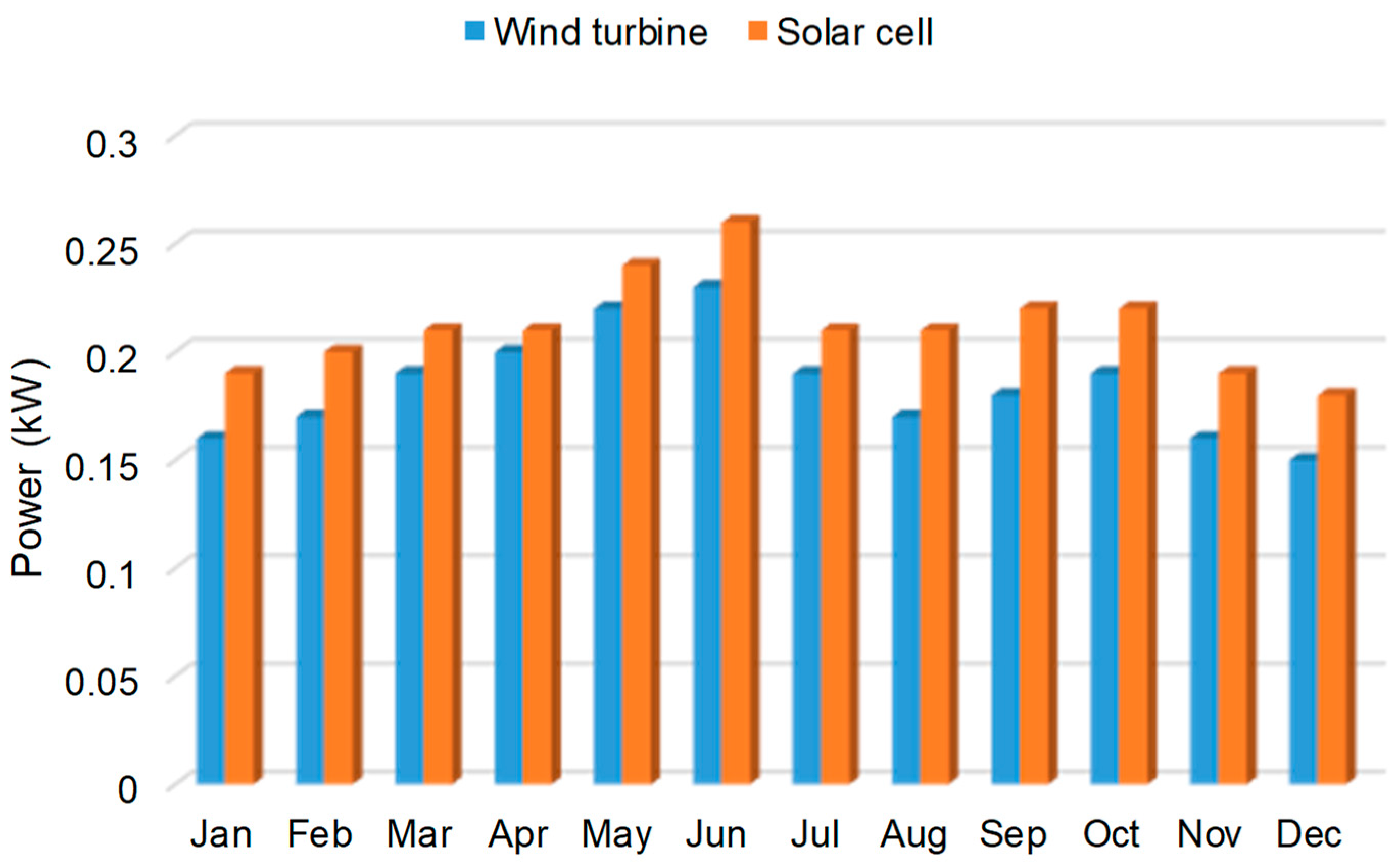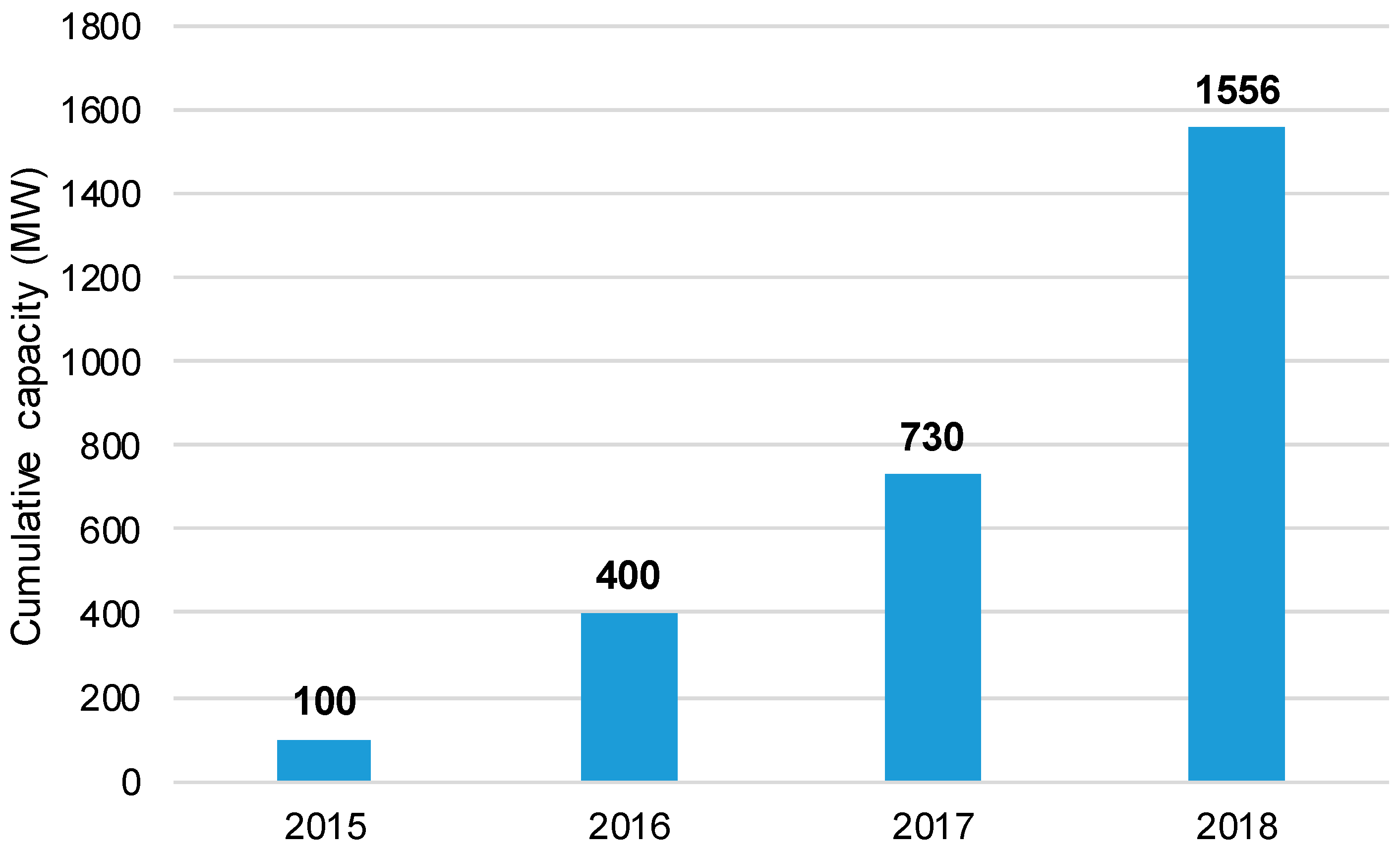1. Introduction
Energy plays a key role in the development of modern economies. All human activities i.e., education, health care, agriculture and employment require energy for proper functioning. A country cannot succeed without proper utilization of energy. It is considered the main component of a country’s economy [
1]. Pakistan is a developing country. Due to recent development and to support its large population and industry, the country needs a huge amount of energy to keep all things on track [
2,
3]. However, there is a shortage of energy supply and the country is in its worst energy crisis. The gap between electricity demand and supply has been increased in the past few years and is highly obvious during summer season [
4] which has resulted in the complete shutdown of power for 10–12 h in urban areas and for 16-18 h in rural areas [
5,
6,
7,
8].
Energy shortage problems not only affect the life of individuals but also hindering the economic development of the country. All sectors including agricultural, industrial, transport, domestic and energy generation have been affected severely due to long power outages and caused huge economic loss to the country. The current share of renewable energy is insufficient in the total energy mix of Pakistan [
9]. The country fulfills its energy needs by utilizing fossil fuels [
10]. Huge dependency on fossil fuels not only has a burden on the national economy but also have led to different environmental hazards like the greenhouse effect, CO
2 emissions, global warming and irregular weather patterns. Moreover, natural resources are being exhausted due to overuse of fossil fuels. Hence, there is a need to develop a new energy economy. In this new economy, renewable energy sources (wind, solar and biomass) will be utilized to produce energy which can decrease the fossil import bill on one hand, and lessen the climatic challenges on the other hand [
11].
Energy demand is increasing by more than 9% annually in Pakistan. It is expected that energy demand will increase 8-fold by 2030 and 20-fold by 2050 in Pakistan [
12]. The major reason of energy crises in Pakistan is that energy structure is mainly dependent on thermal resources including coal, oil and natural gas which are expensive as well as are under huge pressure of shortage. In the recent past, the share of hydroelectricity has reduced significantly. Moreover, renewable energy sources only fulfill 0.3% of the energy needs of the country, which is almost negligible. Among different renewable energy options, solar energy has the potential to tackle all these challenges. It has emerged as the most competitively priced technology worldwide. According to the International Energy Agency, global capacity of solar PV had reached 402 gigawatts (GW) at the end of 2017. It will further expand by almost 580 GW and lead the renewable electricity capacity growth [
13]. Luckow et al. [
14] found out the institutional and technical barriers associated with solar energy. The European commission carried out research programs on solar energy for almost two decades to reduce pollution and carbon emissions, ensure energy security and diversify energy mix of European countries [
15].
Geographically, Pakistan lies in the sun belt and receives massive amounts of sunlight all through the year. To address the current energy issues, it is very important to exploit the existing solar energy resources. Meanwhile, public and private sector investment is very important to harness its true potential [
16]. Many researchers have focused on solar energy to estimate its potential for proper utilization in the country [
17]. Khalil and Zaidi [
18] found out the reasons for energy crises in Pakistan. Shaikh et al. [
19] stressed on the importance of solar energy as a natural asset for Pakistan. Farooq and Shakoor [
5] suggested solar thermal as the best option for current energy crises in the country. Farooq and Kumar [
20] assessed the technical potential to generate electricity from solar technology. Shakeel et al. [
21] reported that the country has an overall solar power potential of 1600,000 MW. Mirza et al. [
22] discussed the outlook and status of utilization of solar energy in Pakistan and highlighted the role of research and development organizations to develop solar energy in the country. Muneer et al. [
3] described the potential applications of solar thermal i.e., solar water heaters for the textile industry. Ghafoor and Munir [
6] designed an off-grid PV system for domestic users. Some researchers found challenges associated with renewable energy [
23,
24,
25,
26,
27,
28]. But no one has tried to compare indigenous renewable energy sources over different factors to realize the best energy choice for Pakistan.
To bridge this research gap, it is very crucial to carry out comprehensive research. This study is the first attempt to find out the best energy option for Pakistan, among many renewable energy sources. We have compared the efficiency of wind turbines and solar radiation intensity in four major cities of Pakistan. For this purpose, data was collected every month for a period of one year. The data was then analyzed by employing MAT Lab and RT Screen. The research findings indicate that solar energy is the best renewable energy option for Pakistan due to many factors such as price, operation and maintenance costs and life span. Moreover, we found the major barriers associated with solar energy in Pakistan by conducting semi-structured interviews with industry professionals. Finally, we have proposed policy recommendations for government and key stakeholders to overcome these barriers and further develop the solar power industry in Pakistan.
The paper is organized as follows,
Section 2 examines the worldwide status of solar energy.
Section 3 compares the solar energy utilization among Pakistan, India and China.
Section 4 discusses the geography, topography and socioeconomic profile of Pakistan. The current energy scenario in Pakistan has been described in
Section 5.
Section 6 discusses the grid structure and situation of solar energy in Pakistan.
Section 7 illustrates the methods used to conduct this research. Solar energy applications have been described in
Section 8. Barriers to solar energy development have been discussed in
Section 9.
Section 10 is devoted to the policy recommendations for solar energy development. And finally,
Section 11 concludes the study.
4. Geography, Topography and Socioeconomic Profile of Pakistan
Pakistan is placed between latitude 24° and 37° north and longitude 62° and 75° degrees east. It is surrounded by 4 countries. On the north side, it shares its border with China. On the south side, there is Arabian sea. India is on the east side, Iran on the west side and Afghanistan is on the north-west side of Pakistan. Punjab, Sindh, Baluchistan, Khyber Pakhtunkhwa and Gilgit Baltistan are the five provinces of Pakistan. Many federally administered tribal areas are also located in Pakistan [
22,
34].
In Gilgit Baltistan and northern areas of Pakistan, there are some of world’s largest mountain ranges i.e., Himalayas, Hindukush and Karakoram. The world’s second highest mountain K-2 is also found in the Karakorum range [
16]. The provinces of Punjab and Sindh consists of flat plains and five rivers which eventually join the Indus river. The Indus is the largest river of Pakistan. On the west side there is the Baluchistan Plateau which is an arid tableland surrounded by dry mountains [
22,
35].
Pakistan is the 6th largest country by population in the world. According to the United Nations report, the current population of Pakistan is 202,272,196. Out of a total population, 39.5 percent of the population lives in urban areas. The country has a total area of 796,096 km
2 [
36]. In 2018, the gross domestic product (GDP) had reached 300 billion US dollars with an annual growth rate of 5.8% GDP. In a developing country like Pakistan, the services and facilities are inadequate to address the increasing demands of population and economy for energy, resulting in increasing pressure on scarce energy resources. it is expected that the annual GDP growth rate will decrease from 5.8 to 5.4% in 2020, causing high poverty and a low standard of living in Pakistan [
37]. Although, current government policies have helped in reducing poverty, a large population is still below the poverty line and living on less than 2 US dollars per day.
Figure 4 compares the population in South Asian countries living below
$ 2 per day. It is quite interesting that Pakistan ranks 3rd in this category, while more poor live in India and Bangladesh [
38].
5. Current Energy Scenario in Pakistan
Since last century, the demand for energy has increased tremendously all over the world and Pakistan is no exception. All human activities require energy for proper functioning. Pakistan is struggling with a huge energy crisis at the moment, which not only hindering the progress of country but also affecting the daily life of people. All major sectors of Pakistan i.e., agriculture, transport, industry and domestic needs a continuous supply of energy. Due to the continuous demand for energy, the gap between electricity demand and supply has increased, resulting in the depletion of energy resources [
39].
Table 2 shows the electricity installed capacity from different sources in Pakistan from the period of 2012 to 2016 [
4].
Although, with the completion of recent projects the total power generation capacity of Pakistan has reached 25,374 MW. But still there is a huge electricity demand and supply gap in the country. In the past few years, this gap has been increased many times. According to the National Electric Power Regulatory Authority (NEPRA), the gap was 5298 megawatts (MW) at the end of 2016.
Figure 5 shows the electricity demand and supply gap from the period of 2012 to 2016. It was expected that this gap would continue until 2018, as shown in
Figure 6. Meanwhile, electricity prices have increased enormously which makes its affordability difficult for domestic and industrial consumers [
40].
The major reason for the power shortage and energy crises is that the overall mix of energy in Pakistan is extremely dependent on oil, LPG and natural gas which constitutes 78.8% of the total 70.3 million tonnes of oil equivalent (MTOE). The share of hydroelectricity in the primary energy supply of the country is 11%, coal 7%, Nuclear Electricity 2%, Imported Electricity 0.15%, LNG imported 0.67% and renewable energy 0.27%, respectively, as shown in
Figure 7.
In terms of per capita energy consumption, Pakistan is still behind many south Asian countries.
Table 3 shows the per capita energy consumption among different South Asian countries [
13]. It is clear from the table that many South Asian countries have higher per capita energy consumption than Pakistan.
51 million people still do not have access to electricity in Pakistan. This poses a great challenge to the Pakistani government and policy makers, as electricity is a necessity of modern life. During 2016, the electrification rate was 74% in Pakistan (urban population 90% and rural population 63%).
Table 4 compares the electricity access in 2016 among major South Asian countries [
41].
5.1. Meteorological Data
The National Renewable Energy Laboratory (NREL) has developed a geospatial toolkit and solar maps to begin solar energy projects in Pakistan, as there is no authentic data available about solar irradiance. For this purpose, nine locations were recognized to gather reliable and accurate solar data. The Alternative Energy Development Board (AEDB) has installed weather stations at these prime locations as shown in
Table 5 [
42]. The World Bank has provided the required funding for the project. The World Bank will publish more accurate solar maps after observing the data taken from these weather stations for a period of two years. These maps and atlases not only help the government but also encourage commercial developers to make their policies accordingly for future projects [
43,
44]. The World Bank consistently monitored solar energy potential in different areas of Pakistan from 2000 to 2012 and published solar map Diffuse Horizontal Irradiance (DHI). According to this map, two provinces of Pakistan (Sindh, Baluchistan) have the highest solar potential. In Punjab province, some deserted areas are also ideal for solar energy. If properly harnessed, solar energy can turn out to be a sustainable solution for the energy problems of the country.
5.2. Resource assessment of Solar energy in Pakistan
According to the Medium-Term Development Framework 2006, Pakistan plans to increase the share of renewable energy technologies (RETs) in the overall energy mix to up to 9700 MW by the end of 2030. The country can achieve these targets and tackle energy crises if it utilizes solar energy resources in a proper and efficient way. Pakistan is located in sun belt [
22]. An enormous solar potential exists in the country. Sindh, Baluchistan and some southern parts of Punjab have abundant solar energy potential. These areas receive 2 MWh/m
2 solar irradiation and 3000 h of sunshine per year, which are perfect to invest in solar energy to utilize its true potential [
45]. Baluchistan alone has tremendous solar energy potential. The average global insolation is 19–20 MJ/m
2 per day and the annual mean sunshine duration is 8–8.5 h, which is perfect for the installation of solar PV and other solar energy related projects. The average temperature of the country is Celsius 26
0-28
0. Meanwhile, the daily average solar power potential is 5.3 kWh/m
2 [
46]. The country has an overall 1,600,000 MW solar power potential [
21]. If solar PV panels were installed only on a 100 Km area of Pakistan with 14% efficiency, it could generate 30 million tons of oil equivalent (MTOE) energy in the country [
47].
The distribution and transmission network of electricity in Pakistan is old and weak. Solar energy can relieve this traditional electricity network and turn out to be an alternate to traditional electricity in remote areas, where no grid electricity is available. Solar energy has already gained popularity all over the world. Current work has been going on to improve the storage capacity of the cells used in solar PV. It is also important at this point in time to make effective policies, followed by clear strategies and models to realize solar potential in the country. In this regard, Public-private partnership can turn out to be very fruitful. Different solar applications are being used in Pakistan, including solar thermal, solar PV and desalination. Meanwhile, solar thermal energy production and solar water heaters also have huge potential. Heavy reliance on fossil fuels for power generation can be minimized and the electricity demand and supply gap can be fulfilled by utilizing solar energy appliances effectively at home, public places and industries. Moreover, it will further guarantee sustainable development of the country [
16].
6. Research Methodology
We employed a hybrid research methodology. First, we collected data of solar radiation intensity and wind speed every month for a period of one year in four major cities of Pakistan, namely Karachi, Lahore, Bahawalpur and Faisalabad. To ensure accurate locations for maximum solar radiation and wind speed, the NASA solar map of Pakistan and wind map of Pakistan were utilized [
48,
49]. Data was then calculated and plotted against the 1 kW solar PV and wind turbines by using MAT LAB and RT screen to compare the efficiency of solar PV and wind turbines (
Figure 8,
Figure 9,
Figure 10 and
Figure 11).
We began our research from Karachi city. Located in Sindh province, the coastal city Karachi is the biggest city of Pakistan. The city is famous for Bin Qasim and Karachi sea port. Due to numerous industrial zones, the city is the economic hub and revenue engine of Pakistan. The share of this city in total GDP of the country is 25%. Due to massive energy demand by domestic and industrial users, the electricity shortfall has reached 412 MW.
Figure 8 compares and analyzes the monthly average electricity generation from wind turbines and solar PV in Karachi city for a period of one year. Although, good wind speed is available for a period of 5 months in Karachi to generate enough electricity, solar radiation is almost constant throughout the year, making it a better energy option than wind energy.
Lahore is the second biggest city of Pakistan after Karachi in terms of population. 90 million inhabitants live in this ancient and beautiful city. Lahore electric supply company (LESCO) is the largest electricity distribution company of this city. During the last few years, electricity demand and the supply gap has increased tremendously, due to massive population and industrial activities in the city. Consequently, LESCO is not coping with the ever-increasing demand for energy [
8].
Figure 9 shows that solar energy is the best option for Lahore city, as simulation results indicate that the average monthly electricity generation is higher for solar PV than for wind turbines.
Faisalabad is famous for its textile industry and is called the Manchester of Pakistan. The textile industry accounts for 58% of the total exports of Pakistan. The city’s alone contribution to total exports of the country is 40%. So, Faisalabad is in crying need for energy. Long short-falls make the city more miserable. In order to find the best renewable energy source, it was revealed that solar energy gives better output in this city throughout the year, while wind energy is only appropriate in June (
Figure 10).
Bahawalpur is the 11th largest city of Pakistan in terms of population with 798,509 inhabitants living in this city. The city was the former capital of Bahawalpur state. Being an industrial city, government has liberties and revolutionized key industries including poultry, cooking oil, textile, steel and flour mills. But the city is facing the worst load shedding, hindering the smooth development of industries. In terms of monthly average energy production, solar energy is the most appropriate in this city as compared to wind energy (
Figure 11). Due to this fact, the Quaid-e-Azam solar park has been constructed in this city [
50].
Second, we conducted semi-structured interviews with industry professionals about the different aspects of solar and wind energy to find out the best renewable energy option. These aspects are: price, average life duration, consumption of fuel, operation and maintenance costs. To compare the price of solar PV and wind turbine it was asked
‘What is the cost required to generate 1 kWh wind/solar electricity?’. Similarly, we asked
‘What is the average life span of wind turbines and solar PV?’ to find the life span of both technologies. Another question was included:
‘What is the average maintenance cost/hour for wind power plants and solar PV?’ to find out the maintenance cost. A total of 42 industry professionals were interviewed in these four cities. After considering all parameters of solar PV and wind turbines, the interviewees’ responses revealed that solar energy is much cheaper than wind energy for power generation in Pakistan. As, the cost required to generate 1 kWh energy is 65,000 Pakistani rupees (PKR) in the case of solar energy, while this is PKR 120,000 in the case of wind energy. Similarly, the average life span of solar PV is 25 years. While it is only 10-15 years for wind turbines. Solar PV do not have any maintenance cost while it is PKR 3.5/h for wind energy plants (
Table 6). Finally, interviewees were asked about the barriers of solar energy development in Pakistan (see
Appendix A). They revealed that solar energy is facing economical, technological, Information, human resource, social and policy barriers. These barriers have been described in
Section 8.
11. Conclusions
Energy is vital for the socioeconomic progress of a country. Pakistan, like many other under developed countries solely relies1 on traditional fossil fuels to meet its energy requirements. Due to its massive population and recent industrial development, there is a huge demand for energy. Meanwhile, fossil fuel prices have increased recently, and the country has no other means to produce energy, resulting in energy short-falls. The electricity demand and supply gap has been increased tremendously. Due to the increasing energy gap, all sectors of life have been affected severely. Policy makers all over the world are looking for alternate ways of energy to solve energy scarcity problems. Different sources of alternate and renewable energy are being explored in Pakistan as well. We have compared different renewable energy sources i.e., solar and wind, based on price, average life span, emission of hazardous gases, consumption of fuel, operation and maintenance costs. We found that solar energy has emerged as a best source of renewable energy to tackle all the energy challenges as it is cheaper, does not require operation or maintenance costs and have a greater average life span than wind energy. Moreover, good wind speed is only available for 5 to 6 months of the year, while solar radiation is present all through the year in the country. Solar energy can lessen the pressure on the national budget which is being used for importing expensive fossil fuels, especially oil. The use of solar energy is only limited to solar PV, solar water heaters, solar geysers, solar cookers and solar pumps in Pakistan. Though, with the construction of the Quaid-e-Azam solar park and similar projects, the awareness of solar energy and its associated benefits have been increased among people. But until now, it’s share in the total energy mix of the country is negligible. Pakistan’s topography and climatic conditions are ideal for the utilization of solar energy at its maximum level. Finally, we have provided some policy implications to address the barriers in the way of solar energy, make people aware about the current energy problems of the country, by supporting and promoting solar energy practices and attract local and foreign investors to invest in solar power projects. To conclude, solar energy has the potential to solve Pakistan’s energy crises in a short time period.
